This scout report will detail Christie Murray. Having just ended a two-year stay with Liverpool Women, we will use data and footage to analyse the Scottish international. The purpose of this tactical analysis will be to identify clubs that could best utilise Murray’s abilities in the upcoming campaign.
Profile
Murray is a 30-year-old Scotland international. She has spent the majority of her career playing with Glasgow City in the SWPL and Doncaster Women and Liverpool Women in the WSL. She is a very flexible midfielder, capable of playing in any position in the centre of the pitch.
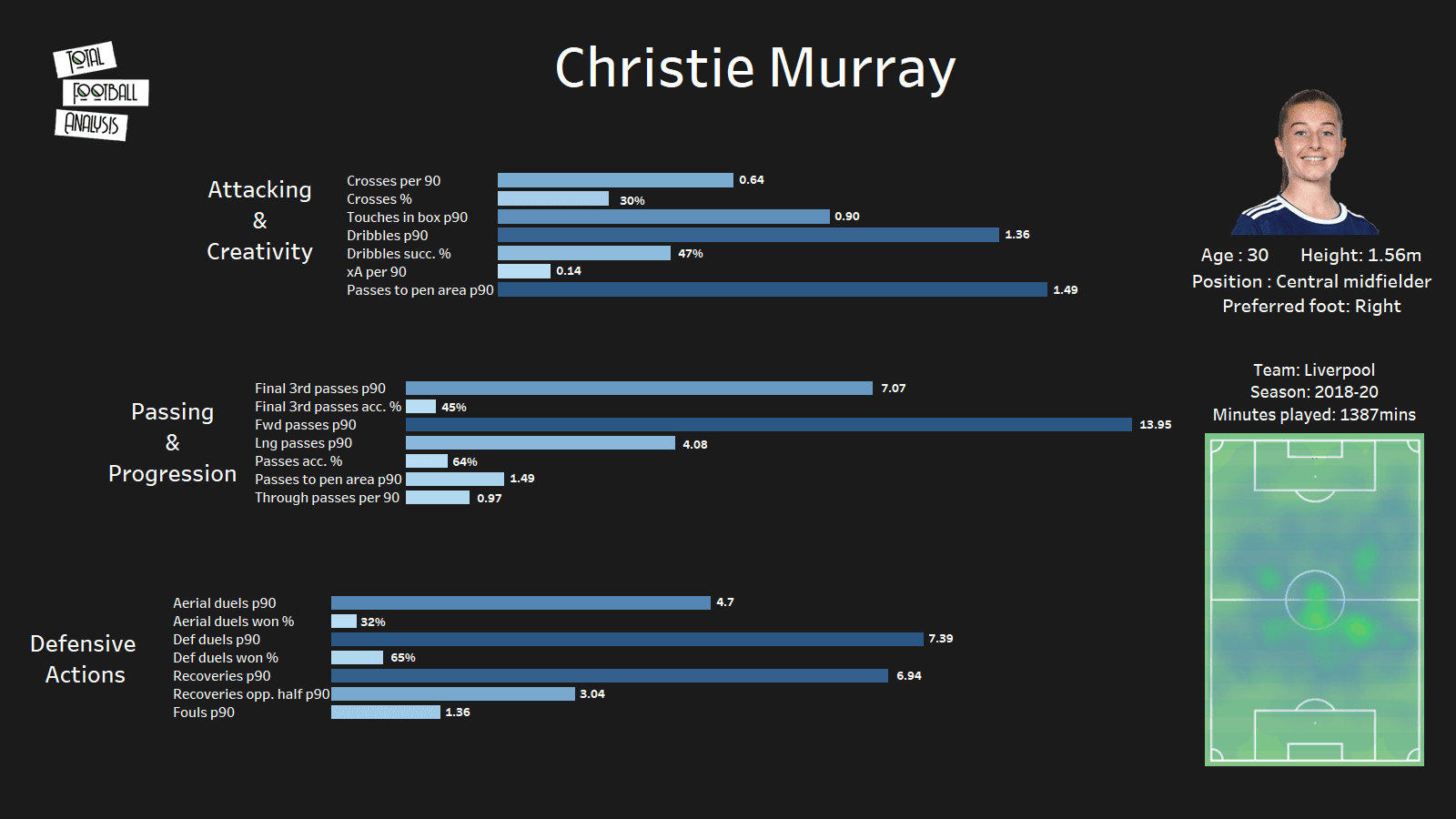
In possession, Murray’s eye for a pass allows her to drive her teams in attack. Her focus on finding entry options into the final third makes her a dangerous player for opposing teams to have to defend against. Her defensive numbers are also very impressive for a player who is used in advanced roles in addition to deeper positions.
While her minutes last campaign were cut down from the 2018-19 season in which she was a crucial member to the Liverpool side, her abilities still make her a valuable asset for many teams. In this analysis, we will detail Murray’s strengths that include her ability on the ball but also her intelligence when she is off of it.
In possession
When in possession, Murray is extremely forward-thinking in her passing decisions. 7.07 of her 29.12 passes per 90 over the course of the last two campaigns are attempts into the final third. Per 90 she averages 1.23 shot assists, further representing her efforts to try and find that final pass when she is in possession. She particularly looks for space in the channels to find her teammates in. This includes finding runs from the wingers or the striker dragging off from their central position into these areas in behind.
In the image below Murray holds possession for Liverpool in the centre of the pitch. The majority of her team is deeper on the pitch as the opposition were making aggressive attempts to win possession back. However, instead of looking to reset possession and start in their build-up, Murray makes a lateral run towards the touchline and gets her head up to look for options.
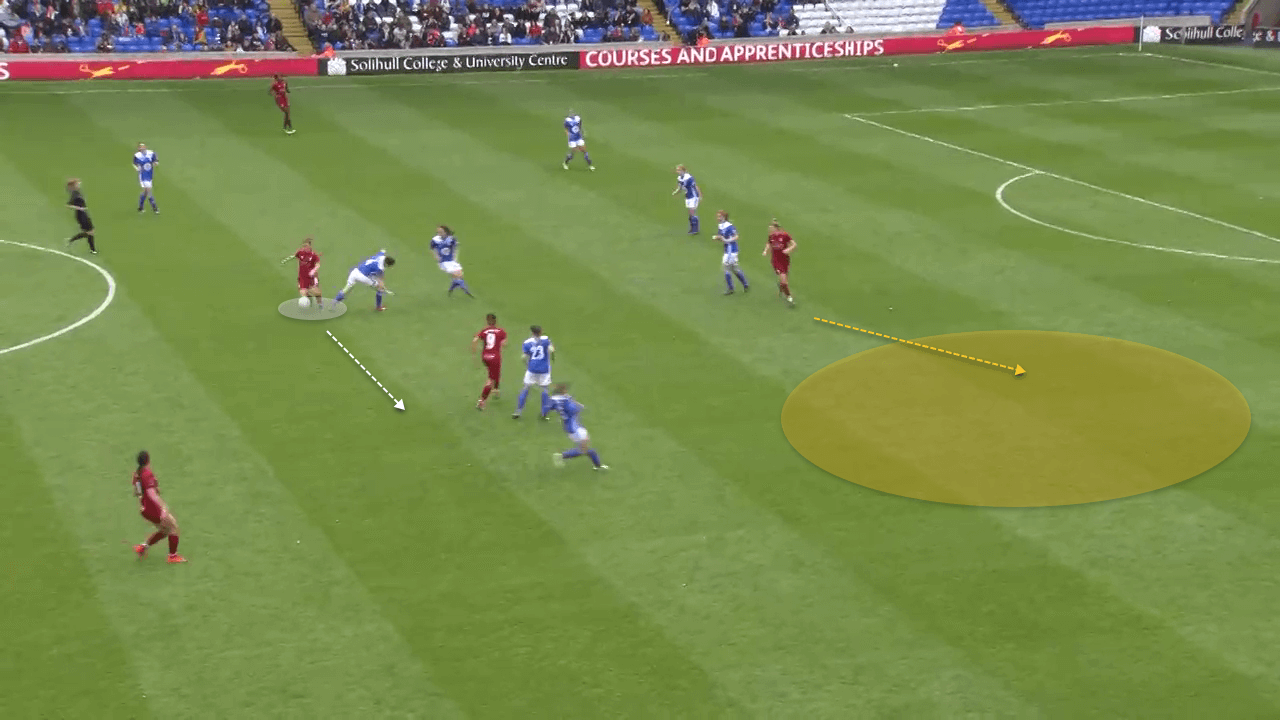
She makes herself a yard of space from her marker and sees her striker making a run off of the back of the full-back. She plays a curling pass around this defender and into the space in behind. With this run and Murray’s preference in playing these types of passes, another teammate has recognised the potential opportunity and moved into an advanced central position to be ready for a cross from the striker.

Off the ball movement
As we will detail in the next two sections, Murray’s best attributes actually come in her time off the ball. In both attack and defence, her work rate and intelligence represents a major asset to her side. As seen in her heat map in the profile section from the WSL in the previous two campaigns, her presence throughout the pitch is evident. Instead of her time spent focused in specific areas, she is comfortable moving throughout the pitch to assist her teammates throughout different phases of the game.
There are two primary areas Murray looks to move into. Working in advanced roles, she works to identify space for her team to expose in the opponent’s defensive line. One of the methods she uses to do this is making diagonal or lateral runs from inside out to the wide area. This is used to attempt to draw out a holding midfielder or centre-half and open space in the middle of the pitch for a teammate to move into.
She also moves into the half-space on either side of the pitch to assist in the progression of attacks. Murray is adept in finding pockets of space in these areas with room to shift the point of attack or help overload the side possession is held on. In the image below Scotland have moved possession out to the left where their winger has the opportunity to run 1v1 against her full-back. Quickly Murray identifies space in between the defensive and midfield lines in the left half-space and moves to offer support.

She is found with a pass inside into this area before the winger jumps around her defensive marker. Murray makes a first-time pass into the space in behind the defensive line and Scotland are into the penalty area with space to attempt a cross.
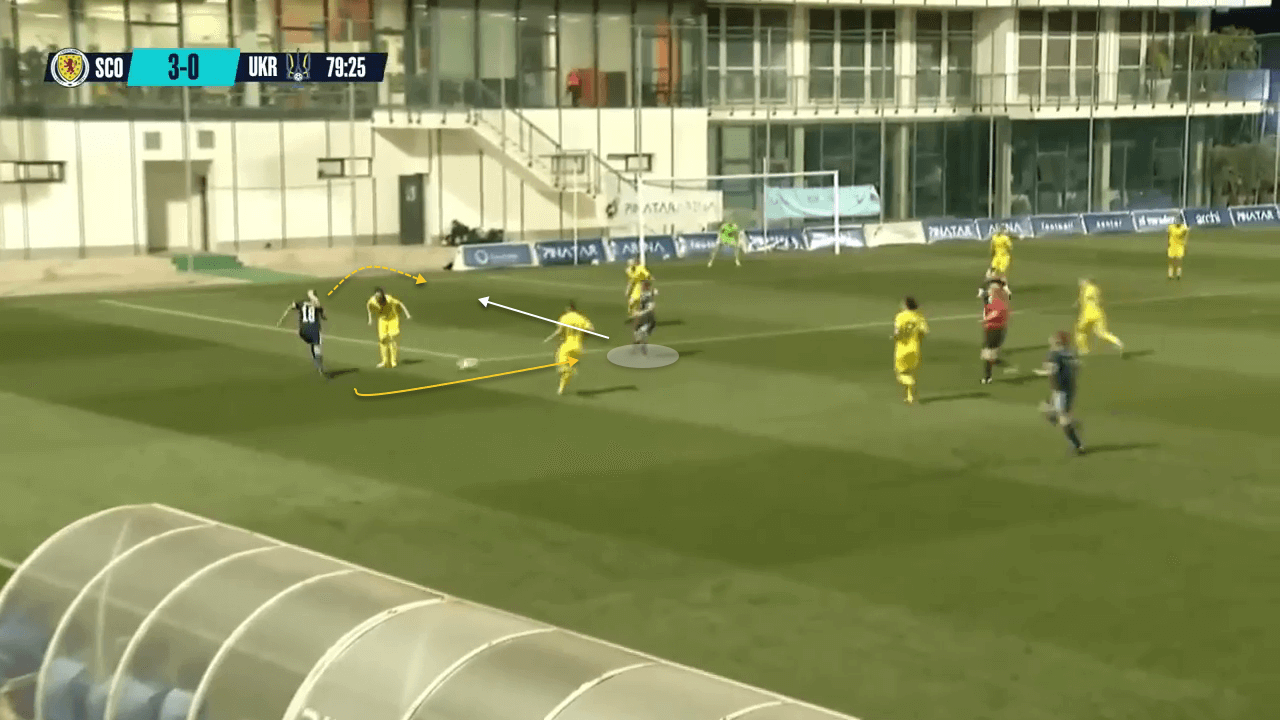
Murray’s movement off the ball makes her a great asset for sides. Looking ahead, her next team should allow her the attacking freedom to move into these wider positions and assist in building up play in either channel. Her eye for a final ball provides a dangerous edge coupled with her experience at the highest level of English football.
Pressing ability
Murray’s pressing work in the defensive phase of the game. As we stated in the profile section, her flexibility allows her to work in numerous defensive schemes and make an impact. For Scotland, she often occupies a higher, more attacking role, playing in behind one or two strikers. For Liverpool Women, she has occupied this area in their usual 4-2-3-1 system but has also filled in both of the two holding midfield spots.
Murray averages 7.4 defensive duels per 90 for Liverpool since joining. She is successful in 65.8% of these, which showcases her intelligence in deciding the right times to make a defensive challenge. Her 3.05 recoveries in the opposition half also represent this ability to lead the initial line of press for her sides, further emphasising her ability to play in both advanced and deep roles.
Her intelligence allows her to anticipate play one or two passes before it occurs, giving her time to move into a position to make an interception or block off forward movement from the opposition. While her playing time has decreased over the previous campaign, this was one of the highlights of Liverpool’s use of her in 2019 and to begin 2020. In the last 30 minutes of so of matches, she was brought in for her work rate out of possession.
The image below comes from Liverpool’s 1-1 draw with Chelsea Women earlier this campaign. Murray was brought in as the attacking midfielder to provide defensive cover from this higher position. As Chelsea look to move possession from Liverpool’s right side after attempts to attack down this channel were unsuccessful, Murray makes a run along the blindside of the centre-back.
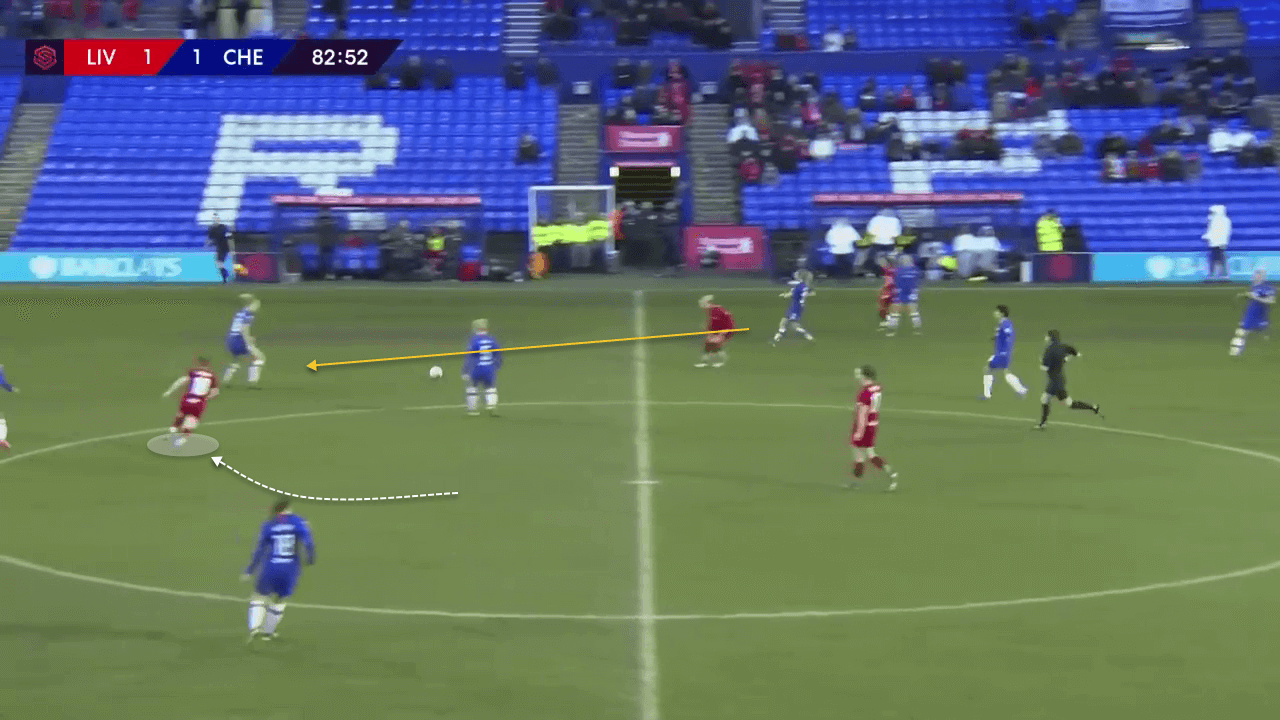
The route of her run presents a false option in the middle of the pitch. This was by design by Murray, and as soon as the centre-back commits to making this pass into her midfielder, she jumps into the passing lane to intercept the pass.
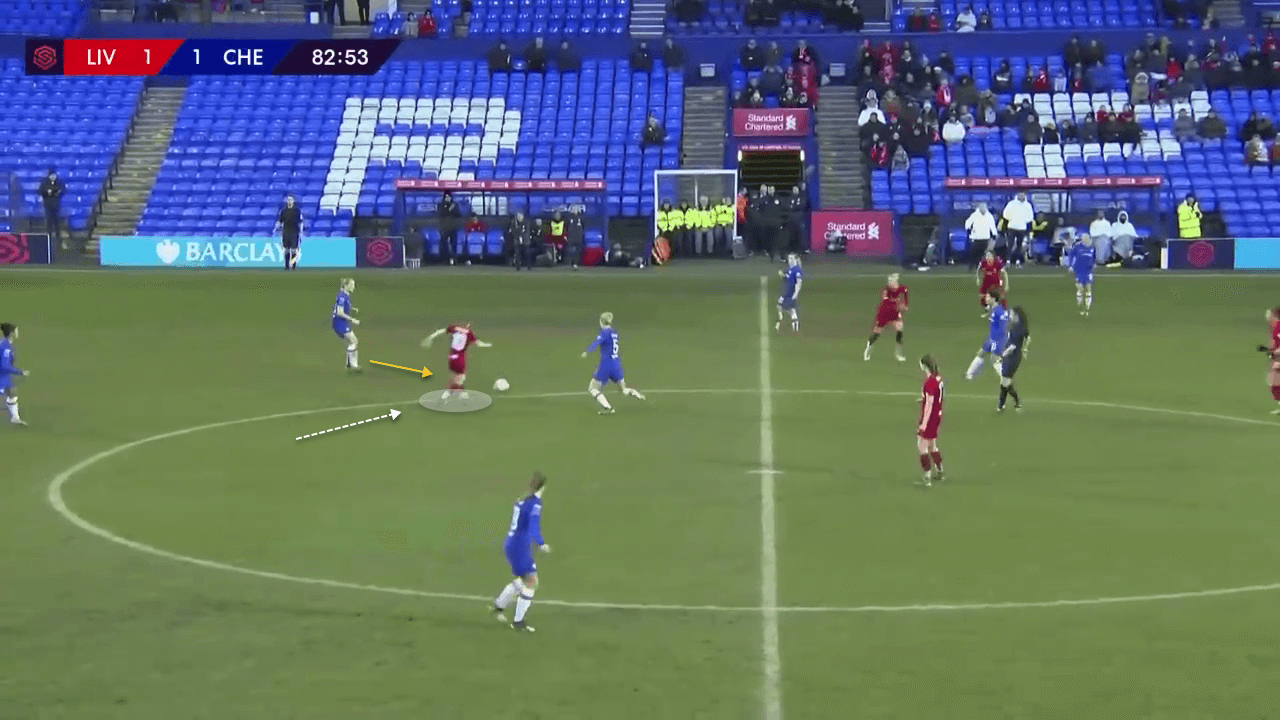
Murray’s qualities suit a team that looks to press higher up the pitch. In a 4-2-3-1 formation in which she players in the number ten position, she would be able to dictate play using her movement and passing in possession, and play a hybrid role in the defensive phase. She is able to join the striker in the initial pressing line shifting the side into a 4-4-2, and drop in just ahead of the two holding midfielders when opponents get into the middle and final third.
Potential new clubs
In this final section, we have identified six teams that utilise tactics that match Murray’s style of play. These have been found using data and this tactical profile of Murray’s strengths. We believe a side which has a low passes per defensive action (PPDA) representing a high press would suit Murray’s defensive efforts. In attack, she is capable of playing in both counter-attacking and possession-based sides given her passing range and intelligent movement off the ball.
Team: Brighton and Hove Albion (England)
Formation: 4-4-2 (29%), 4-4-1-1 (21%), 4-5-1 (18%)
Style of play: A potential option for Murray might be the high pressing Brighton and Hove Albion.
Brighton under Hope Powell have usually preferred a 4-4-2 formation. The set-up typically sees a flat two-striker system from structured restarts by the opposition, complemented by two banks of four behind. This can, however, adapt into a 4-4-1-1 with the 10 looking to link midfield and attack, or provide additional support to the midfield to become a five. These are set-ups Murray has strong experience of playing in.
Brighton are always looking for opportunities to press high in an effort to regain the ball in their opponent’s defensive third, which would suit Murray’s game either as a 10 or central midfielder. Their initial forward line is quite aggressively positioned on structured restarts such as opposition goal kicks. Forward players will set up just outside the penalty area, tempting the opposition defenders to play out from the back, but holding a compact central shape, ensuring a progressive pass cannot be slid between them into midfield. Once the press begins it will be aggressively supported by the midfield in an effort to win the ball, hurry the next pass to win possession subsequently or force the opponent long: Murray’s pressing abilities higher up the pitch would work well with this approach.
The Seagulls put an emphasis on vertical compactness. The midfield and defensive units will stay closely connected and push up behind the forward lines: Brighton clearly take the attitude that they would prefer the opposition to play around or even over them, rather than through them. They often look for triggers to press on, such as slow square passes, the ball moving into wide areas, or players, particularly central midfielders, receiving the ball with their backs to goal. Again, Murray’s strong ball recovery numbers could see her fit into such a system where she can anticipate and then launch the press in central midfield.
This tactic marries up with Brighton’s attacking play. After regaining the ball, they look to play forward quickly and vertically to take advantage of the opponent still being out of shape on the transition: this could work well with Murray’s passing characteristics. Powell’s team also like to play forward as soon as it is on to do so, and prioritise field position over ball retention at times, so Murray’s keenness to often look to play forward might be of value to them. They could certainly use some help here, ranking second bottom of the league for shot-creating actions per 90 with 13.2.
It’s also worth noting that Brighton’s most effective and creative midfielder, Lea Le Garrec, has alternated between the number 10 and central midfield positions this season, so Powell might well be looking for another player with similar abilities, thus allowing Le Garrec to settle in one position instead of having to cover multiple bases.
Team: Birmingham City Women (England)
Formation: 4-2-3-1 (46%), 4-1-4-1 (23%), 4-4-1-1 (22%), 4-4-2 (6%)
Style of play:
Birmingham City Women like to play with a version of a 4-4-2 in most of their games, with two strikers and two wingers playing outside of them. That has morphed into a 4-2-3-1 formation in 46% of their matches, and this would suit Christie Murray. She likes to play in the box-to-box role mostly, and this is something Birmingham don’t have at the moment. Their first-choice pairing in midfield so far has been Lucy Staniforth and Chloe Arthur, with Arthur playing in front of the defence and protecting them, and Staniforth getting forward as the more attacking of the two players.
They don’t desperately need another midfielder, as both Arthur and Staniforth are good players, and are adept in their roles. However, they don’t have anyone who can play in defence and then run forwards to the attack, linking up the two different areas of the team. This is where Murray would fit in, adding something different to their team.
They will also need to add more pace to the team, with both left-back Adrienne Jordan and forward Brianna Visalli having both left the team. As Jordan tended to play as a very attacking left-back, it is likely that they will need someone to take on that role. At Liverpool Women this season, Murray tended to drift around the pitch to wherever she needed to be, and to fill the spaces that opened up. This included moving to the wing to allow players such as Niamh Charles to cut inside and get passes or shots away. Therefore, with Birmingham seemingly having a main front four of Lucy Skipp, Abbi Grant, Rachel Williams and Claudia Walker, it is likely that they might be looking for someone who can move to the wing in order to give those players the opportunity to cut inside a little more.
In 23% of their matches, Birmingham have played a 4-1-4-1 formation, and this is where Murray would be most useful to the team. She could sit as the single player in front of the defence, protecting them from any possible counter-attacks, and would also be able to push higher up the field from this role, tackling and intercepting the ball before it reached her own defensive line. This in turn would push the four main midfielders ahead of her further up the field, increasing Birmingham’s attacking proficiency. If she were to be played in the four behind the striker, she could be used to link up the play between the defence and attack, receiving passes from the defensive midfielder and moving them into the striker. As Birmingham have only scored five goals in the 13 games of the WSL season that they played, the lowest in the league this season, this would definitely benefit them.
There is no desperate need for a player like Murray at Birmingham, but there would definitely be positives to the club signing her. She would give them something different, and would fit into their formations, whichever they preferred to use.
Team: Everton Women (England)
Formation: 4-2-3-1 (42%), 4-3-3 (14%), 4-1-4-1 (14%), 4-4-1-1 (7%), 4-5-1 (7%), 5-4-1 (5%), 4-4-2 (5%)
Style of play: Everton Women are an FAWSL team that employ a high pressing system. They often use a 4-2-3-1 system as their primary formation of choice. Here they pair two defensive midfielders with one number 10 who is equally proficient on and off the ball. Murray’s style of play could be a good fit for Everton as her diverse passing range will compliment the dynamic Chloe Kelly and help Everton creatively going forward.
From a defensive perspective, Everton press from the front, starting with the centre forward, and going back to the two defensive midfielders. The idea is to close the passing lanes and allow high turnovers by isolating the full-backs.Having played in a 4-2-3-1 at Liverpool, Murray would have no problem slotting into the system. Murray’s work rate and persistent running could be an asset playing as an ‘8’ or ‘10’. With a 65% success rate in defensive duels, Murray is a good fit for Everton’s out of possession tactics. Though she often plays deeper, the higher tempo and addition of two defensive midfielders can give her a license to push forward and defend off the ball, especially because of her attacking nature on the ball.
Team: Fleury 91 (France)
Formation: 4-4-2 (24%), 4-1-4-1 (19%), 4-4-1-1 (19%)
Style of play: Fleury 91 play out from the back and look for their central midfielders who will try to play directly into the forward line. The centre-forward will usually receive balls deeper and look to play in the attack-minded central midfielder who will they bring the wide players into play. They will then look to find opportunities from the wide spaces.
Team: KIF Örebro (Sweden)
Formation: 3-5-2 (65%), 3-4-1-2 (20%)
Style of play: KIF Örebro are one of the few European teams that use a wing-back system with three central defenders. They primarily use the wide players to attack and have two central midfielders who are very active and often stay within passing range of each other. KIF Örebro use a lot of movement in their build with their attacking players making off the ball runs which could suit Murray’s playmaking play style. The central midfield setup could benefit her attacking playstyle with each player providing defensive cover and providing a short, simple passing option.
Team: Brisbane Roar (Australia)
Formation: 4-2-3-1 (42%), 4-4-2 (24%)
Style of play: Brisbane Roar primarily use a 4-2-3-1 with a balanced central midfield partnership. They build out from the back using their central defenders and play through the middle initially. The two full-backs will push up and use their width but have on occasion moved centrally to provide defensive solidarity. Murray could benefit from their constant movement in midfield and through passes into the willing runners from the wings. The team adopts a mid to high pressing system with the midfield getting more aggressive as the ball moves towards the central areas.
Team: SC Freiburg (Germany)
Formation: 4-2-3-1 (39%), 4-4-2 (37%)
Style of play: Freiburg primarily utilises two formations in which we have shown the contribution Murray would have in. They look to press very high and base a large number of their attacking tactics off of winning possession when their opposition has numbers forward and attacking quickly. When they establish possession, the German side looks to attack the wings, where Murray prefers finding through passes into.

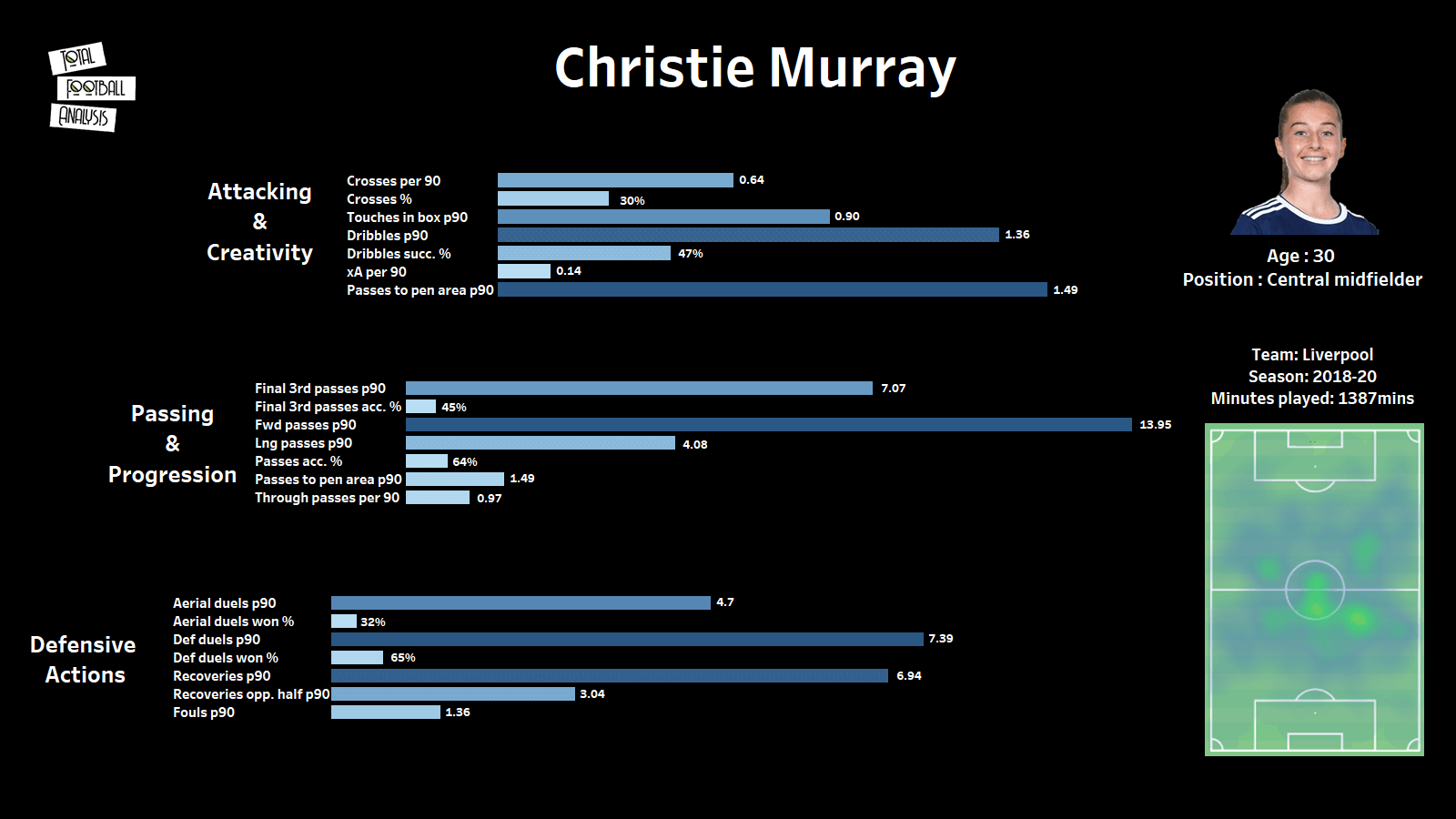




Comments